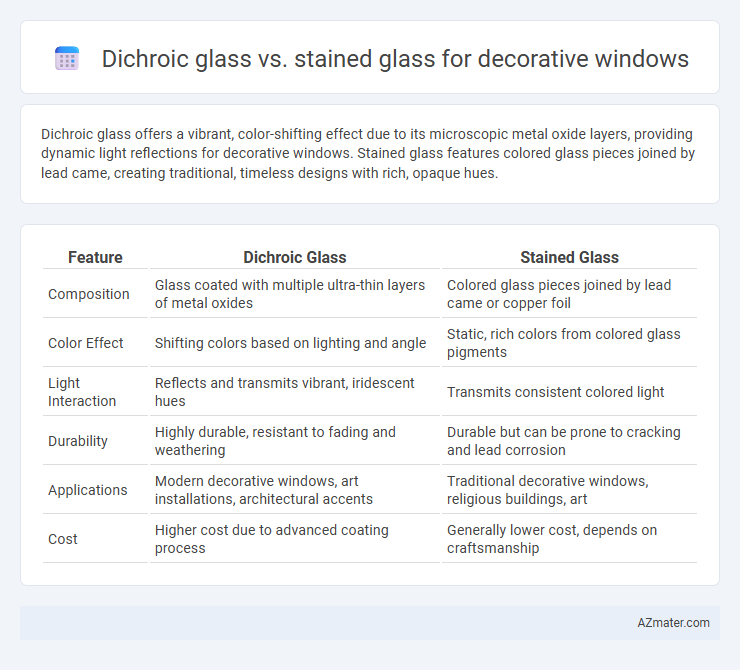Dichroic glass offers a vibrant, color-shifting effect due to its microscopic metal oxide layers, providing dynamic light reflections for decorative windows. Stained glass features colored glass pieces joined by lead came, creating traditional, timeless designs with rich, opaque hues.
Table of Comparison
| Feature | Dichroic Glass | Stained Glass |
|---|---|---|
| Composition | Glass coated with multiple ultra-thin layers of metal oxides | Colored glass pieces joined by lead came or copper foil |
| Color Effect | Shifting colors based on lighting and angle | Static, rich colors from colored glass pigments |
| Light Interaction | Reflects and transmits vibrant, iridescent hues | Transmits consistent colored light |
| Durability | Highly durable, resistant to fading and weathering | Durable but can be prone to cracking and lead corrosion |
| Applications | Modern decorative windows, art installations, architectural accents | Traditional decorative windows, religious buildings, art |
| Cost | Higher cost due to advanced coating process | Generally lower cost, depends on craftsmanship |
Introduction to Dichroic and Stained Glass
Dichroic glass features multiple ultra-thin layers of metal oxides that produce vibrant color shifts and reflective qualities, making it ideal for modern decorative windows. Stained glass consists of colored glass pieces joined by lead or copper foil, traditionally used in intricate designs and historic window art with rich, deep hues. Both materials offer unique aesthetic appeals, with dichroic glass emphasizing dynamic color changes and stained glass focusing on classic, handcrafted artistry.
What is Dichroic Glass?
Dichroic glass is a unique material that displays multiple colors by reflecting and transmitting light at different wavelengths, making it ideal for decorative windows seeking vibrant, shifting hues. Unlike stained glass, which relies on colored pigments or metallic salts embedded during manufacturing, dichroic glass is coated with ultra-thin layers of oxides that create its signature iridescent effect. This advanced optical property allows dichroic glass to produce dynamic color changes based on the viewer's angle and lighting conditions, offering a modern, luminous alternative to traditional stained glass designs.
What is Stained Glass?
Stained glass consists of colored glass pieces arranged to form decorative designs, often held together by lead came or copper foil, and has been traditionally used in windows to create vibrant, multicolored light effects. It is known for its detailed pictorial or geometric patterns that tell stories or enhance architectural aesthetics. Unlike dichroic glass, stained glass relies on pigments embedded within the glass, resulting in a richly textured, light-filtering display that changes with the angle of sunlight.
Visual Effects and Light Reflection
Dichroic glass displays vibrant color shifts and iridescent reflections due to its micro-layered metallic coatings, creating dynamic visual effects that change with viewing angles and lighting conditions. Stained glass consists of colored glass pieces joined by lead, offering rich, opaque hues and a traditional, painterly appearance that filters natural light into static, warm tones. While dichroic glass enhances decorative windows with shifting luminosity and prism-like refractions, stained glass emphasizes classic artistry and consistent color diffusion.
Durability and Longevity Comparison
Dichroic glass offers superior durability compared to traditional stained glass due to its multiple thin layers of metal oxides, which enhance resistance to fading and weather damage. Stained glass, composed mainly of colored glass pieces joined by lead came, is more susceptible to cracking and discoloration over time, especially when exposed to harsh environmental conditions. The longevity of dichroic glass in decorative windows exceeds that of stained glass, making it a preferred choice for installations demanding lasting vibrancy and structural integrity.
Design Versatility and Customization
Dichroic glass offers exceptional design versatility with its ability to reflect multiple colors depending on the angle of light, creating dynamic and vibrant effects ideal for modern decorative windows. Stained glass provides rich, traditional customization through hand-painted details and leaded patterns, enabling intricate storytelling and classic aesthetics. Both materials support tailored designs, but dichroic glass emphasizes contemporary color shifts, while stained glass prioritizes artisanal craftsmanship and timeless elegance.
Installation and Maintenance Considerations
Dichroic glass offers a lightweight installation process due to its thin layers and compatibility with standard glazing systems, reducing labor time and structural support requirements compared to heavier stained glass. Maintenance for dichroic glass is relatively low, as its durable coatings resist fading and weathering, whereas stained glass demands periodic lead frame inspections and potential re-cementing to prevent glass loosening or damage. Both materials require careful handling, but dichroic glass's resistance to environmental factors makes it more suitable for high-exposure decorative window applications with minimal upkeep.
Cost Differences: Dichroic vs Stained Glass
Dichroic glass typically costs more than stained glass due to its complex manufacturing process involving multiple micro-layers of metal oxides that create vibrant color shifts. Stained glass offers a more affordable option, utilizing traditional colored glass pieces fused or leaded together, with costs varying based on glass quality and craftsmanship. The higher durability and unique optical effects of dichroic glass often justify its increased price in decorative window applications.
Ideal Applications for Each Glass Type
Dichroic glass excels in modern decorative windows where vibrant color shifts and dynamic light effects are desired, making it ideal for art installations, contemporary architectural designs, and statement pieces. Stained glass is preferred for traditional or historic settings, such as churches, heritage buildings, and classic homes, where intricate patterns and rich, opaque colors enhance the storytelling and aesthetic value. Choosing between dichroic and stained glass depends on the desired visual impact and compatibility with the architectural style.
Choosing the Best Decorative Glass for Your Window
Dichroic glass offers vibrant color shifts and high reflectivity that change with lighting and viewing angles, making it ideal for dynamic, modern decorative windows. Stained glass provides rich, traditional hues and detailed imagery, often favored for historic or artistic window designs with intricate patterns. Choosing the best decorative glass depends on whether you prioritize contemporary light play and durability or classic craftsmanship and storytelling.

Infographic: Dichroic glass vs Stained glass for Decorative window
 azmater.com
azmater.com